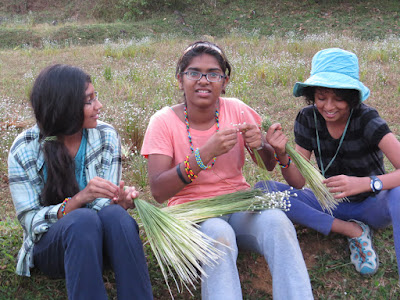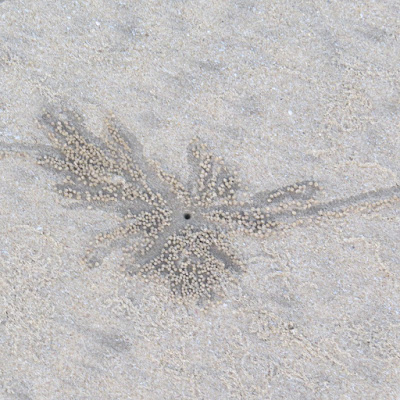Here at Angadibail forest we had our sessions with Banglore Steiner School not only to make functional and beautiful brooms but also to bring back the broom making tradition.
you can see some of these steps in action!-a personalised experience
A simple craft of broom making
Imagine a field full of wild-flowers, white heads popping out of the green, inviting you to come and lie down amidst all that beauty.
Well, Seetakka brought us here for a task ...she wanted us to focus and start the work ...She came as a teacher to teach us how to make brooms out of this grass ..
If you want to make a designer broom there will be no lying down. You need to get to work and pull out the long stalks/grass with the white heads to make the brooms locally called “hittumbe hidi”.-she called us right there .
Sitakka - our broom teacher showed us the best patches to harvest the stalks.
You'll find the longer (better) grasses in the damper places. They're also easier to pull out than the more dried ones.
She showed us a technique for even this simple task of grass pulling- you turn your palm upwards, slide your fingers into the stalks, let the heads get caught in the gaps at the base of your fingers and then pull upwards.
The next part of the task is to clean or remove the loose grasses off the ends called hokkalu . when you are pulling the main grass hokkalu is attached to it . Hokkalu meaning navel. this is the part of the stalk you disconnect from the rest of the plant.
Harvesting these wild grass with a beautiful flower was so much fun ..We posed... We smiled ...we held the big bunch of flowers close to us so that no one take it ..They were looking so beautiful!
We smiled . ....we posed again.... we felt like we were preparing a bouquet for someone's wedding in the forest ....
Suddenly our broom instructor gave us a shock. She explained the next step..and asked us to pinch off the white tip -the flower- named after another body part, the head or “burude” !! Such a sad thing to do ...:(((..Shaan was not at all pleased with this
 |
Once you have collected a big enough bunch you pinch off the white tip..
|
 |
| Such a painful task to remove the head |
It was getting dark ... So we decided to go home and do the task
Before beheading the grass we thought we take a photo of these beautiful flowers
. Once beheaded, we spread our bunch of stalks out in the sun to dry a few days.
When we met Sitakka after 3-4 days of drying, we took along a string/jute rope /suthli each with our bunch of grass . Your rope must be tied one side and then a loop made in the rope at one end and then the other end tied up tightly so you can work comfortably one it.
Then starts the knotting/wrapping of the grass stalks. It is a fairly simple process, taking two stalks at a time and wrapping them around the previous two.
Despite its simplicity it does requires some application to get the weave tight enough and neat enough.
Sitakka inspects our work offering demonstration and corrections as needed, “do it neatly”, “make the end shorter”, “do it tighter”.
It seems more involved and tedious than it the intermediate “grass skirt” result seems to merit. And we need to make it long enough.
Wow! It was quite beautiful. The dried grass gave it a goldish sheen and the spiralled top a majestic finish. Even if your length of grass is a bit shorter, you can still make yourself a slimmer broom like some of us did! "Chanda...chanda..."-Seetakka admired our brooms ...
-With Neesha Norohna






























































